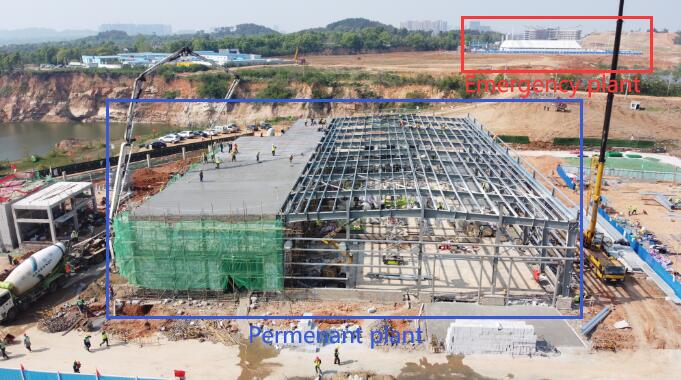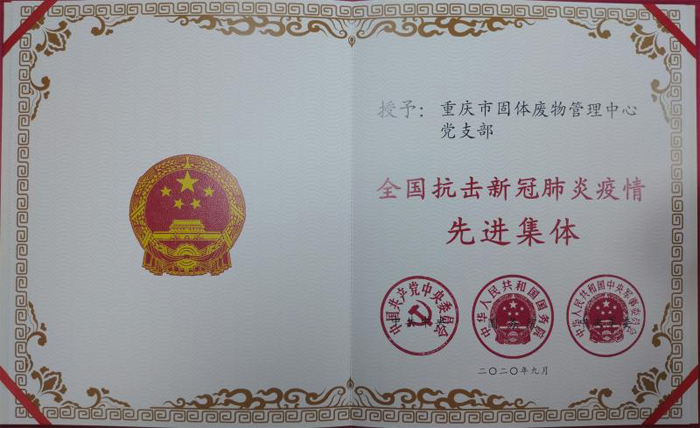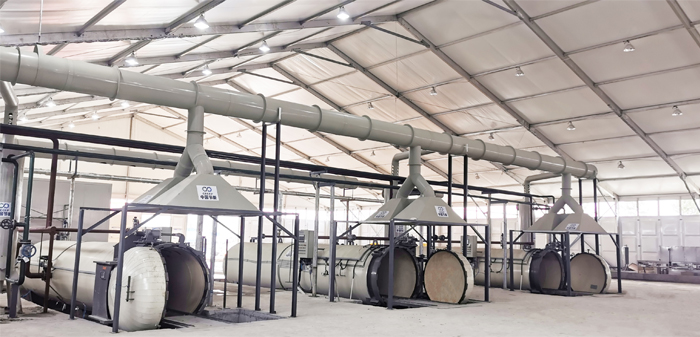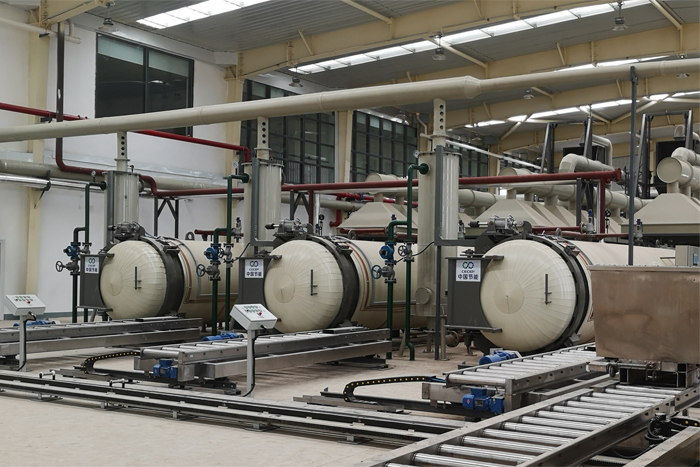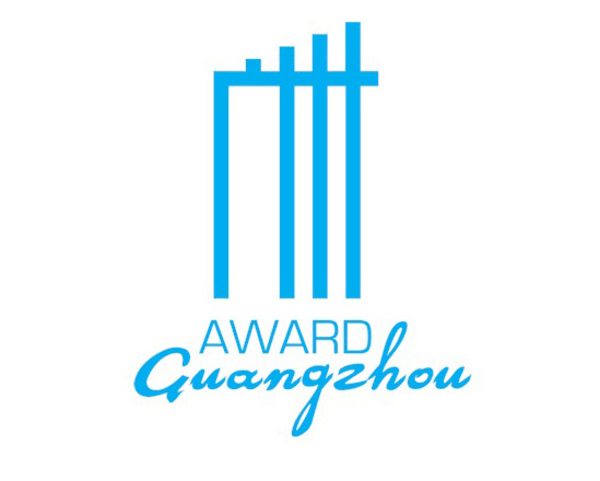 Map - © Chongqing Municipality
Map - © Chongqing Municipality- Medical waste plants in Wuhan - © Chongqing Municipality
- National Award for Contributions against COVID-19 - © Chongqing Municipality
- The emergency medical waste treatment plant completed in 14 days - © Chongqing Municipality
- The permanent medical waste disposal plant (phase I) - © Chongqing Municipality
City
Chongqing
Main actors
City Government, National Government, Private Sector
Project area
other
Duration
Ongoing since 2020
Innovative Emergency Solutions during COVID-19.
With the global outbreak of COVID-19 and the subsequent ecological crisis, many cities are facing the challenge of increased medical waste. Based on experiences from the 2003 outbreak of SARs, the Chongqing municipality has developed emergency solutions to address urban medical waste disposal, which have been successfully applied in Wuhan and Chongqing. This provides a model that other cities can follow for the disposal of medical waste and the improvement of urban safety resilience during the pandemic.
Guangzhou Award
This project was shortlisted for the 'Guangzhou Award' in 2020.
Due to the sudden outbreak of COVID-19, the disposal of medical waste became an urgent priority for the municipal governments of Chongqing and Wuhan. The city of Wuhan’s daily medical waste rapidly increased from 45 tons to 247 tons, far exceeding its daily disposal capacity. The Wuhan government had only one private operator for medical waste disposal and requested help from the Ministry of Ecology and Environment of the People’s Republic of China (MEE). MEE and Wuhan municipal government asked the China Energy Conservation and Environmental Protection Group (CECEP) to provide a solution. CECEP selected a private operator from Chongqing, Gient, who were the only supplier able to provide assistance at that time.
Wuhan
Wuhan emergency medical waste disposal center and the permanent medical waste disposal plant have a capacity of 30 tons/day respectively and serve 388 hospitals in the 16 districts of Wuhan, benefiting approximately 14 million residents. The emergency disposal center for medical waste was built in 14 days, taking into account the need to limit the risks of infection within it.
The construction of the emergency medical waste disposal center is based on several partnership models between the central government-municipal government, government -industries, city-city and state-owned companies-private companies. MEE, the lead partner made an urgent decision to approve the construction of two disposal plants.
- CECEP was responsible for the investment, construction and operation of the plants,
- Chongqing Gient was responsible for in-situ technology and equipment,
- Wuhan Environmental Investment Group provided the local support for CECEP
- Chongqing Municipal Government provided the administrative support for rapid procurement of complete sets of equipment required by Gient for the two plants.
Chongqing
Early in the COVID-19 crisis, Chongqing municipality increased their daily capacity to 90 tons/day for medical waste disposal. This expansion involved 426 front-line management and disposal staff and 125 special vehicles for medical waste and help to safeguard the health of 32 million residents and their environmental safety.
The Emergency Mechanism included a daily report, dispatch, analysis and research. A warning system was applied to the operation load of disposal facilities. If 80% load was exceeded, other forms of temporal emergency disposal facilities should be started (such as mobile disposal facility, incineration plants, etc.).
The department in charge of transportation ensured a clear pathway for vehicles loading medical waste and the department of healthcare and the economic and information commission ensured the provision of medical protective equipment.
Due to the lockdown, it was not possible to have a participative process during the design phase. However, during the implementation phase, many volunteers, medical staff, low-income people and women were involved.
As there are no manufacturers for medical waste disposal equipment in Wuhan, the only operator for medical waste disposal could not respond to complicated situations due to lack of technical capability. Chongqing is a leading city in the manufacturing of complete sets of equipment for medical waste disposal and is well serviced by Gient and a group of supporting factories, forming a powerful industry chain.
An advance-funding construction and operation model was adopted for Wuhan emergency medical waste disposal center. In the first instance, the hospitals were not charged for the construction and operation of new waste disposal facilities. After the end of the outbreak, Wuhan Municipal Government audited the investment, then an agreed lump sum was paid to construction and operation units. The construction fund of the permanent disposal plant shall be borne by the construction party, and the investment will be gradually recovered through the subsequent provision of charged medical waste disposal services to the hospitals in Wuhan.
Wuhan
With the help of Chongqing, an emergency disposal center for COVID -19 medical waste was constructed and operated in Wuhan, including processed medical waste from LeiShen Shan and HuoShenShan makeshift hospitals and other 16 districts, ensuring service provision for Wuhan residents. The rapid completion of Wuhan emergency medical waste disposal center played a significant role in the timely disposal of medical waste during COVID-19. It processed 1/4 of the medical waste from Wuhan including two large makeshift hospitals. After the completion of a 60t/day medical waste disposal plant, the annual disposal capacity can achieve 19800 tons with 100% safe disposal. This has both improved Wuhan’s medical waste disposal capacity and provides a model for other cities around the world.
Chongqing
From the outbreak of COVID-19 to July 11, 2020, the accumulated medical waste disposal in Chongqing amounted to 11600 tons, meeting the requirements of “all receivable”, “daily clear”, “safe disposal”. The principle of 100% environmental supervision to the hospitals and 100% collection and disposal of medical waste in Chongqing was implemented to ensure the scientific regulation of medical waste, which effectively prevented secondary infection and virus spread.
Challenge: powerful resource scheduling and integration
Solution: good collaboration and efficient decision-making mechanism
Challenge: the conflict between the prevention and control capacity for medical waste disposal
Solution: the government and the community should pay prevention-based medical waste disposal “margin” far exceeding daily needs
Challenge: insufficient policy and regulation support
Solutions: improving regulations, standards, facilities and technology; ensuring data quality control, enhancing training and awareness; achieving standardized medical waste management.
Lessons learned
The construction of Wuhan emergency medical waste disposal center in 14 days (instead of 10 months under normal circumstances) demonstrated a rapid and replicable approach. In the permanent disposal plants, new technologies have been adopted to create an environmentally friendly and smart work environment, preventing the operators from infection. The most important attributes to achieve the desired outcome were collaboration and technology. The collaboration involved a large number of people involved nationally, a clear division of responsibilities and quick response. Hundreds of officials, experts, technicians, workers, medical staff and volunteers were involved.
Measures taken to sustain the innovation over time:
Establish a mechanism to keep track of the results and ensure continuous improvement of the innovations to guarantee the continuous use of the facilities and emergency mechanism post-pandemic.
Undertake studies on what Chongqing can learn from the Wuhan experience, such as regular training for staff related to medical waste, regional collaboration for co-disposal of medical waste, rational planning of medical waste disposal facilities.
Transferability
Because of the successful application of innovative solutions in Wuhan, MEE encouraged Chongqing to share its Wuhan experience with other cities. Several cities in China are already re-organizing their capacity of medical waste disposal facilities based on this model and building environmentally friendly medical waste disposal facilities. At the same time, plans for emergency disposal facilities should be prepared to improve the local medical waste disposal capacity in case of another large-scale outbreak of the pandemic.
The Solid Waste Management Center of CEEB won the national award for its excellent contribution against COVID-19. After this meeting, as the only city winner in the medical waste management and disposal sector, Chongqing is ready to share its innovations with other Chinese and global cities.
Guangzhou Award application form
On Map
The Map will be displayed after accepting cookie policy
